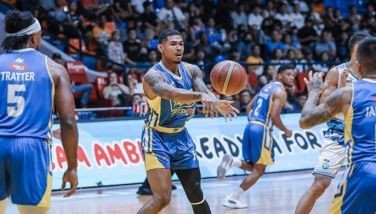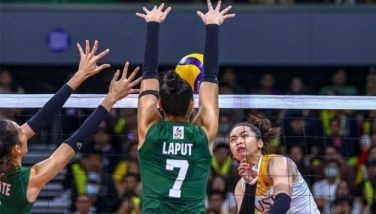Growth of an industry
College basketball season is always an exciting time for sports journalists, and more so for sports broadcasters. It’s always a season to look forward to, providing a constant source of entertainment and showcase of young Filipino talent. More than that, for those of us working in the broadcast industry, it is a heartwarming reminder of how far the industry has grown, and the potential for things to come.
The first account of what may be considered a sporting event was found in a cave painting in France. The illustration, made some 15,000 years ago, commemorated the remarkable (some would say foolish) stand a lone caveman made against a two-ton bison. The gigantic beast, roughly the size of a van by today’s standards, charged the hunter and his tribesmen. While his friends fled, he stood his ground, and with his crude weapon, disemboweled the monster, getting killed in the process. At the time, his accomplishment would have fed his village for nearly a month, cause for genuine celebration. The crude drawing in colored paint probably taken from crushed berries, immortalized the unnamed warrior’s heroic last stand.
Before this writer even started working almost three decades ago, radio was the prime mover in sports coverage. In the 1960’s DZHP under Larry Cruz and anchored by respected veterans like Joe Cantada, Ed Tipton, Ronnie Nathanielsz and then a budding sports editor named Recah Trinidad, set the bar for those to follow. They amassed all the major awards available at the time, and did back-breaking work, like covering the Tour of Luzon live. It was that kind of exposure that eventually encouraged patrons to jump in, and it became the Marlboro Tour, and now the impressive LBC Ronda Pilipinas. The only other staple at the time was the coverage of Fistorama, which provided the foundation for every other boxing broadcast to follow.
In 1976, RPN 9 covered the Munich Olympics, and imagine how difficult that must have been. The challenges of transmission, with video production still in its infancy, the time difference, and the difficulty of covering all the events simultaneously. It was history in the making, though, notwithstanding the fatal attack on Israeli athletes midway through the games.
Just a few years later, marketing master Carlos “Bobong†Velez, originally a footballer, decided to take his passion for basketball to the next level. Gambling on a vision to improve Philippine sports broadcasting, Velez negotiated for both the radio and television broadcasts of the Philippine Basketball Association, which had already been covered for both media. The first generation of talent Velez assembled have all become legends of the industry, beginning with the late Cantada and Pinggoy Pengson. Pengson’s catchphrase “cardiac game†referring to a thrilling contest was even recognized by Time magazine.
Joining the panel were Ed Picson, Sev Sarmenta, the late Butch Maniego, fellow STAR columnist Quinito Henson, Andy Jao, the late Romy Kintanar and a few seasons later myself, Jimmy Javier, Jim Kelly, Chino Trinidad, and others. But it was Velez’s direction that moved everyone to keep getting better. Vintage’s leader was a stickler for detail, and the post-production meetings were always long and sometimes emotional. His single-mindedness set in stone the direction for the industry. There were many breakthroughs in the late 1980’s to early 1990’s, from the use of the language and statistics to marketing basketball to pioneering multiple-camera replays. There was the occasional culture class, as old-timers on both the engineering and even broadcast panel sides resisted changing their ways. But Velez stood firm on the way he believed things should be. And he was proven right. Vintage eventually started covering other sports like boxing with the same professionalism.
People’s Television, for a time, held a monopoly on major international events such as the Southeast Asian Games, Asian Games and Olympics. Despite its small crew, they always delivered a comprehensive coverage, particularly in the 1991 SEA Games held in the Philippines. It was also the broadcasting debut for some of the next generation of sports broadcasters, many of whom were former athletes themselves.
Along the way, there have been independent broadcasters who have steadfastly maintained their commitment to sports television. Butch Gamboa and Pocholo Ramirez became the standard for motoring magazine shows with their decades-long partnership on Sunshine TV’s “Motoring Todayâ€. Ron delos Reyes still travels the country and the globe for “Automotive Reviewâ€. Each program has at one time spawned a spin-off. Rolly Baron focused on golf and tennis and a handful of other sports which became a staple on the old People’s Television. A handful of other dabbled in both TV and radio, following in their footsteps. Silverstar Productions must be credited with improving college basketball broadcasts, and keeping interest in school sports alive.
The EDSA Revolution opened the door for ABS-CBN to enter the fray. Its initial foray was a regular sports magazine show entitled “Sportsweekâ€, written and hosted by Frank Evangelista and this writer. One of the first event broadcasts was an international bout featuring Pretty Boy Lucas. I clearly remember it as the first time I was splattered with blood while commentating at ringside. Soon, the network would set its sights on bigger game.
After its attempt to bid for the broadcast rights of the PBA did not meet success, ABS-CBN focused its merchandising might on the new Metropolitan Basketball Association, a regional league based out of major cities around the country. But they went big, buying two broadcast vans expressly for the coverage, one for the north, one for the south. Transporting the technical personnel, equipment and two sets of announcers per gameday entailed tremendous cost, but they wouldn’t have it any other way. Veterans Sarmenta, Maniego, Bob Novales and myself were partnered with many newcomers, and this resulted in the discovery of Mico Halili and Pia Arcangel, who have done us all proud beyond words.
What the constancy of the PBA coverage and those huge leaps forward have done is prove that sports television is viable, even in what is considered a small market. This has set the stage for boxing, billiards, mixed martial arts, soccer and other sports to be given their share of the limelight, with more sports waiting in the wings.
For those of us who have seen it all evolve, it is no longer a lonely battle.
- Latest
- Trending
































